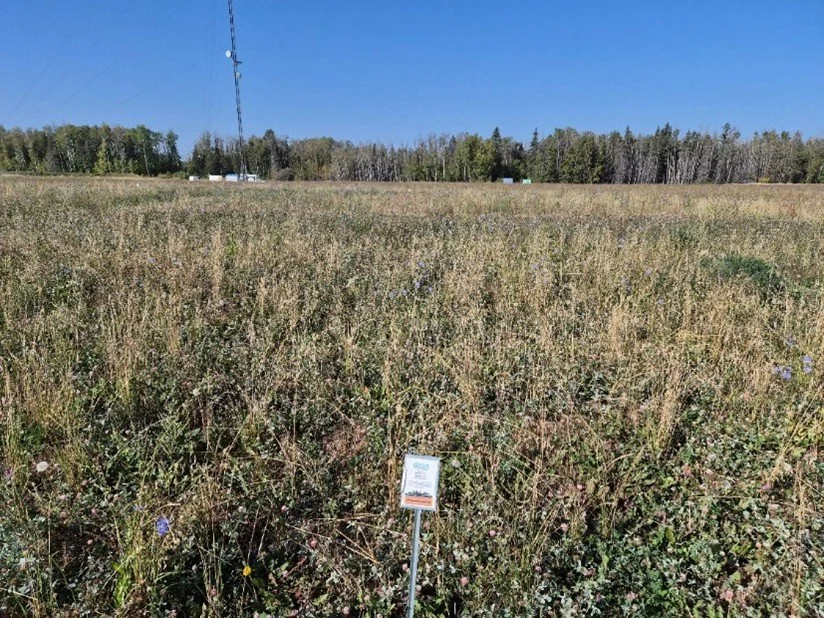News & Insights
Accelerate Weekly is our email newsletter delivered straight to your inbox every Tuesday. Get practical insights, local research updates, and upcoming event info — all tailored for farmers, ranchers, and land managers in Northwest-Central Alberta.
Filter By Category:
Wildwood Soil Health Trial: 2025 In-Season Update
The 2025 Wildwood Soil Health Trial continues to explore how a diverse polycrop blend and several biological amendments influence soil function, forage quality, and field resilience. This fall-season update shares early observations from the third year of this 15-acre project, including feed quality results, field performance notes, and a general yield range. A full report will be released once all data is analyzed.
Kicking Off Our Frost Seeding Project in West-Central Alberta
Farming Forward has launched a new RDAR-funded Frost Seeding Project to evaluate how a diverse forage blend performs under West-Central Alberta’s freeze–thaw conditions. This study will help livestock producers understand which forage species establish best when frost-seeded into existing pastures, and how the practice can improve drought resilience, pasture productivity, and soil health. With the first plots now staked out, soil samples taken, and a new on-site weather station collecting soil temperature data, this project will generate practical, Alberta-based recommendations for producers looking to enhance forage stands using low-disturbance, early-season seeding methods.
Boosting Soil Health with Polycrops and Biological Amendments
How can plant diversity and biological amendments improve compacted, clay-heavy soils? At our Wildwood trial site, we’re putting that question to the test. This research project evaluates five biological treatments alongside a diverse polycrop, measuring impacts on soil health, compaction, water infiltration, and forage quality. Learn more about what we’re testing, why it matters for Grey Luvisol soils, and how it could support more resilient pastures across the region.
Tracking Our Producer-Led Bale Grazing Project: Updates from the Field
We're following a producer-led bale grazing project to explore how different levels of leftover bale residue—or “trash”—influence soil health and forage performance over time. This ongoing blog will share field updates, seasonal observations, and emerging insights from the trial as it unfolds. Stay tuned as we dig into the data and learn alongside our local producers.
Scouting for a Solution: Help Identify Thistle Rust
Join Farming Forward’s province-wide effort to scout for thistle rust fungus—an eco-friendly tool in the fight against Canada thistle. Learn how to identify it and be part of the solution.
2024 Nitrogen Rates in Corn Trial (Producer-Led)
The project compares different nitrogen rates applied at different times in the growing season on corn yield and quality. This project was set up on a local producer’s land, southeast of Barrhead.
Corn is becoming a more popular silage option in the west central area, it is a high energy, digestible feed source. There are many corn hybrids out there that work well in our region. For this trial, PS 2320 RR was the variety used. It’s a roundup ready, dual-purpose corn, with good disease resistance. Producing optimal corn silage requires careful attention to soil fertility. Corn harvested for silage removes more nutrients compared to grain harvest. Understanding the crop’s nutrient requirements is paramount in successful corn silage production.
2024 Aeration Project
This year we worked with a producer in Yellowhead County looking at the use of an aerator on pastureland. The implement used was a 2022 Ranch Worx SL Series single drum pull-type aerator. We wanted to look at the efficiency of an aerator in hopes of eliminating the need for completely reworking the land. Aeration is all about improving soil structure, enhancing water infiltration and increasing oxygen availability. Soil aeration is also necessary for aerobic microorganisms. Given that this land is located in the gray luvisol soil zone, compaction may be a concern as it does have a higher clay content and poor drainage. There are several methods of aeration, mechanical, which are spike aerators and subsoilers/rippers. Rippers and subsoilers are used for deep tillage to break up hardpan layers. There is also biological and natural aeration, biological uses deep rooted cover crops to get through the compacted soil. Natural aeration is using grazing management, rotating the livestock preventing over compaction. Another natural aeration option is controlled traffic farming, it is designed to keep machinery in designated lanes on the field.
2024 Corn Evaluation Trial
Analysis of soil reports from the spring and fall of 2024 reveals a notable increase in organic matter content, rising from 4.6% in the spring to 6.2% in the fall. This increase may be attributed to the specific blend of plant species established, as well as the cumulative effects of multiple years of perennial forage cultivation. Located in the dark gray chernozemic soil zone, this zone historically has lower natural fertility so adding those species and management techniques to increase organic matter is key. This zone also can have higher clay content in areas, leading to compaction concerns and drainage issues. These concerns should be considered when formulating an operational plan.
2024 Polycrop Soil Health Project
The objective of this trial is to evaluate the impact of a polycrop blend on soil health. Soil health is important because it directly impacts plant growth, crop productivity and quality. By understanding and applying some of the soil health principles such as optimizing crop blends and adjusting management strategies productivity can be improved while maintaining soil health. This site has historically had soil compaction issues, so when deciding on the blend, deep rooted species and species that aid in soil structure were chosen. Other factors in creating a blend were weed suppression species and species that adds organic matter. Each species was chosen for its ability to improve different soil characteristics. For example, clover is a nitrogen-fixer and adds organic matter. Japanese millet reduces soil degradation and is a drought-resistant species. Flax helps fight soil compaction and performs well in drought conditions. Sunflowers alleviate soil compaction and can absorb chemicals from the soil.
2024 Hemp Intercropping Trial
Hemp is a versatile crop with numerous applications and agronomic benefits, demonstrating its adaptability to the growing conditions of west-central Alberta. Various cultivars are bred for specific end uses; in this study, we focused on the FINOLA variety, showcasing its ability to produce a viable yield while contributing to soil health improvement. Additionally, our findings indicate that hemp can be effectively harvested through straight combining with minimal wrapping issues. Selecting a variety suited to both agronomic objectives and available harvesting equipment is essential for optimizing production efficiency.
Alberta Soil Health Benchmark Monitoring Project
The status and functionality of a soil should be measured not only by its chemical (fertility) properties but also for its physical and biological properties. Chemical components of soil have been intensively evaluated by commercial soil testing labs in Canada. Chemical fertility recommendations have been based on this knowledge. The role of soil biology, however, is not well understood and physical characteristics have not been monitored.
Perennial Forage Trials (2020-2022)
The majority of the annual feed requirement comes from mixed stands of perennial grasses and legumes, therefore managing these forage resources is very important. Establishing and maintaining a successful hay-land or grazing stand requires significant investment and good management. Selecting varieties which are easy to establish and are resilient while providing high yield and quality can improve net returns for producers.
Industrial Hemp Variety Evaluation Trials (2018-2021)
Beginning in 2018, WCFA has cooperated with the Canadian Hemp Trade Alliance (CHTA) on the National Industrial Hemp Variety Evaluation Trials. WCFA's trials have been established at the Brazeau County Research site (NW 14-049-09-W5M). Each year a number of dual-purpose and grain type industrial hemp varieties are evaluated for grain and/or fibre yield, and cannabinoids.
Soil Moisture In Forage Systems
Utilizing weather stations with attached soil probes, this project is looking at differences in soil moisture profiles in various forage & cropping systems, and the overall usefulness of these technologies for forage producers.
Rancher Researcher Enhancing Technology Adoption (2017-2019)
This project focuses on the process of adopting new innovations and/or technology on Alberta ranches. Producers throughout the province have adopted a variety of innovations on their operations through this project.
Corn Variety Trials
Corn is a high energy feed with protein levels that will normally match the nutritional needs of a dry cow in mid and late pregnancy. It also has the potential to produce more dry matter than tame hay or forage cereals. By replacing other forms of feed with standing corn, labour and machinery use costs are reduced as no summer feed harvesting is required and winter supplemental feeding is limited.
Sire-Progeny Links In Multi-Sire Commercial Herds (2019)
One of the more commonly used natural breeding systems in commercial herds is the multi-sire system. One of the major disadvantages to this system, however, is that producers are often unaware of which bulls are siring calves. The use of genetic technology to assign parentage may allow producers to determine which bulls have sired calves.
Cocktail / Cover Crop Trials (2018)
Cocktail crops have traditionally been used to help hold the soil when transitioning between different types of cash crops, and are often plowed down before planting the next crop to add organic material and fertility to the soil. Farmers with livestock often select cover crops that can be grazed, adding an additional benefit as feed and the advantage of additional nutrients from animal manure.
High Legume Pasture Project (2017)
New sainfoin varieties have shown promise for persistence under grazing in alfalfa-sainfoin mixtures, with comparable yields to alfalfa/grass mixes and are bloat mitigating. The threat of bloat in grazing livestock has stymied efforts by the livestock industry to use higher producing forage crops like alfalfa which could reduce the acres required to support livestock production and provide competitive gain opportunities for feeder cattle. The new emerging sainfoin cultivars will offer the livestock industry the opportunity to take advantage of the productivity, flexibility and profitability of legume based pastures. Sainfoin contains tannins that bind with the soluble proteins and inhibit the activity of rumen microbes; thus slowing the rate of digestion of the forages. A rapid rate of forage digestion has been determined to be a major cause of bloat.
Pollinator Mix Demonstration (2017)
One of the sustainable approaches in conserving our native pollinators is active research for the purpose of developing suitable Pollinator Mixes for specific agro-climatic zones in the country; that can help in establishing Pollinator Gardens or Pollinator Habitats or Pollinator Sanctuaries at suitable sites. Such sites could be farm perimeters, hard to access farm areas, agronomically non-productive or unsuitable wasteland areas, wetlands, city, municipal and rural parks, gardens and lawns, kitchen gardens, avenues, boulevards, golf courses, suitable parts of highways etc. Pollinator Mixes could include mixtures of specific wildflowers, native grasses as well as different annual/perennial forage crops that can actively attract insect pollinators in large numbers.





















